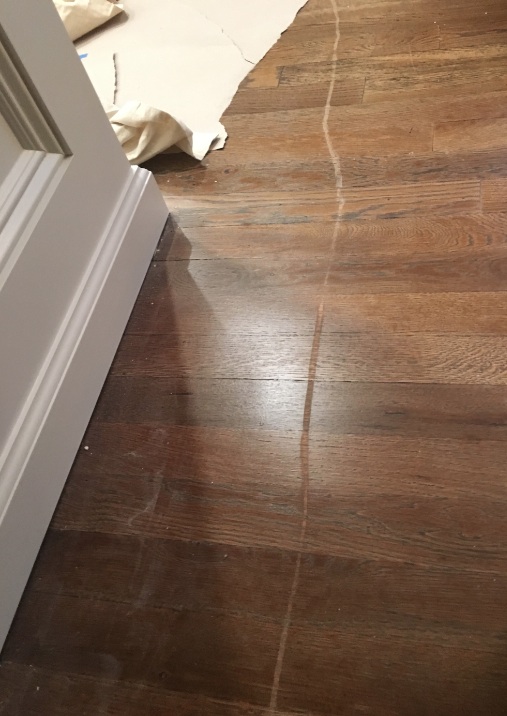Have you ever walked into a room and noticed a deep, unsightly scratch marring your beautiful wood floors? It can be a heart-wrenching sight. Whether it’s from a heavy piece of furniture, a playful pet, or just the everyday wear and tear of life, scratch marks on wood floors are a common problem. But fear not! With the right knowledge and techniques, you can effectively remove or minimize these blemishes and restore your floors to their former glory.

Image: viewfloor.co
This comprehensive guide will delve into the world of wood floor scratch repair, empowering you to tackle this common issue head-on. From understanding the different types of scratches to exploring various repair methods, we’ll equip you with the tools and knowledge to combat those pesky marks and breathe new life into your floors.
Understanding Wood Floor Scratches: A Closer Look
Before diving into repair methods, it’s essential to understand the different types of scratches you might encounter. This knowledge will help you choose the most effective approach and maximize your chances of a successful restoration.
Surface Scratches
These are the most common type, caused by light abrasions that only affect the top layer of the wood’s finish. They typically appear as fine lines or shallow grooves, and they are often easy to repair.
Deep Scratches
These are more severe, extending beyond the finish and into the wood itself. They can be caused by sharp objects or heavy impacts. While these scratches are more challenging to fix, they’re not necessarily impossible to remove.

Image: homeyimprovements.com
Gouges
Gouges are the most significant type of scratch, leaving deep, irregular marks in the wood. They are often caused by heavy objects or blunt force and can be difficult to repair without professional help.
Simple Solutions for Surface Scratches:
For surface scratches, you’re in luck! Many simple solutions are readily available at home. These methods focus on restoring the finish and minimizing the appearance of the scratch.
1. Wood Floor Polish or Wax
For minor scratches, a simple application of wood floor polish or wax can often work wonders. These products fill in the scratches and create a smooth, even surface, effectively hiding the imperfections.
2. Furniture Polish
Similar to wood floor polish, furniture polish can also help minimize the appearance of surface scratches. Its polishing action can smooth out the scratch and make it less noticeable.
3. Mineral Oil
Mineral oil is a natural and effective remedy for surface scratches. Apply a small amount to a soft cloth and gently rub it into the scratch, allowing it to penetrate the wood. The oil will fill in the scratch and restore some of the lost shine.
4. Toothpaste
Yes, you read that right! Non-gel toothpaste can be surprisingly effective in removing surface scratches. Apply a small amount of toothpaste to a soft cloth and gently rub it into the scratch. Rinse the area with water and dry thoroughly.
Tackling Deeper Scratches:
For deeper scratches that penetrate the wood’s finish, more intensive methods are required. These techniques involve filling the scratches and restoring the wood’s appearance.
1. Wood Filler
Wood filler is a specialized product designed to fill in gaps and scratches in wood. Choose a wood filler that matches the color of your floor as closely as possible. Apply the filler to the scratch with a putty knife, smoothing it out carefully. Let the filler dry completely before sanding and finishing.
2. Wood Stain Pen
A wood stain pen is a convenient tool for concealing deeper scratches. Simply apply the stain to the scratch, following the grain of the wood. Let the stain dry completely before applying a sealant to protect the repair.
3. Sanding and Refinishing
For deep scratches that cannot be easily filled, sanding and refinishing are often necessary. This involves sanding the affected area to remove the scratch and then applying a new finish to the floor. Be cautious when sanding as it can create more damage if done incorrectly. Consider consulting a professional for this step, especially for complex floors or extensive damage.
Preventing Future Scratches:
Once you’ve successfully repaired those pesky scratches, it’s essential to take steps to prevent them from happening again. A few simple precautions can go a long way in protecting your wood floors.
1. Protective Mats
Use protective mats under furniture with sharp legs or heavy bases to prevent scratches. These mats create a barrier between the furniture and the floor, absorbing any impact and safeguarding your wood’s surface.
2. Felt Pads
Attach felt pads to the bottom of furniture legs to reduce friction and prevent scratching. These pads create a smooth, gliding surface, allowing furniture to be moved without damaging the floor.
3. Regular Cleaning
Regular cleaning is key to protecting your wood floors. Dirt, grit, and debris can create abrasive particles that scratch the finish over time. Sweep or vacuum your floors regularly to remove these harmful substances.
4. Avoid Abrasive Cleaners
Some cleaning products can be harsh on wood floors, causing scratches or dulling the finish. Choose cleaners specifically designed for wood floors and avoid using abrasive scrubbers or cleaners that contain harsh chemicals.
How To Get Scratch Marks Off Wood Floors
Conclusion
Dealing with scratches on wood floors can be a frustrating experience, but it doesn’t have to be overwhelming. By understanding the nature of scratches and utilizing the appropriate repair methods, you can effectively minimize their appearance and restore your floor to its original beauty. Remember, prevention is key! Implementing precautionary measures like protective mats, felt pads, and regular cleaning can help keep your floors scratch-free for years to come.






